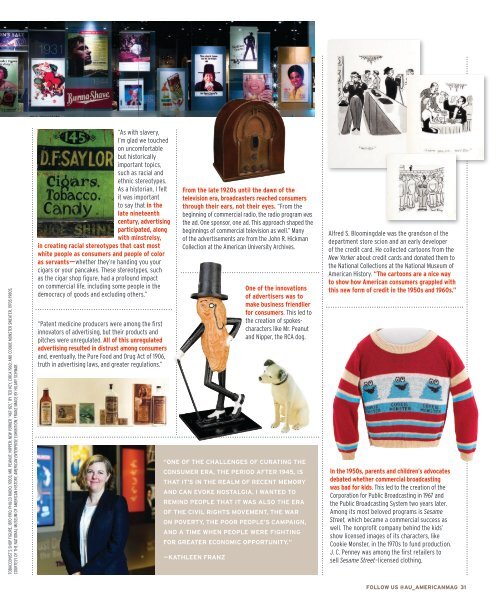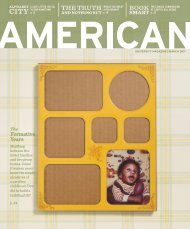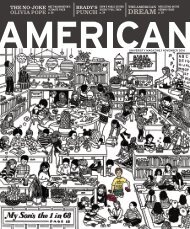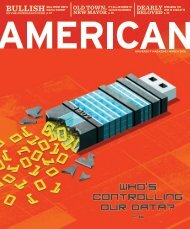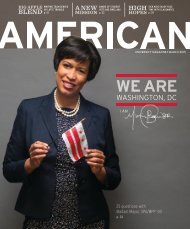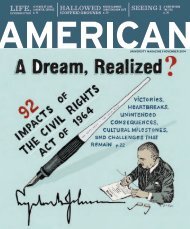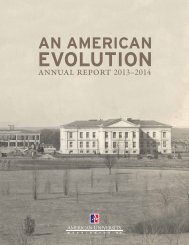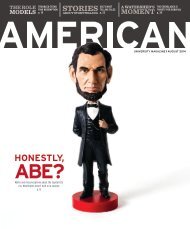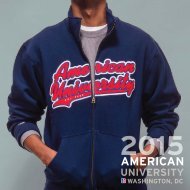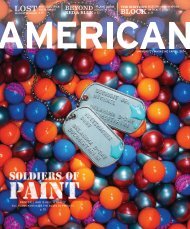American Magazine, July 2015
This issue, meet Maryland First Lady Yumi Hogan, learn about Kogod’s startup incubator, explore the Smithsonian’s new American Enterprise exhibit, hop on the Metro to Navy Yard—Ballpark, and get to know some of AU’s 1,200 Atlanta transplants. Also in the August issue: footwear on campus, 12 Eagles to follow on Twitter, and a new quiz with a tasty prize.
This issue, meet Maryland First Lady Yumi Hogan, learn about Kogod’s startup incubator, explore the Smithsonian’s new American Enterprise exhibit, hop on the Metro to Navy Yard—Ballpark, and get to know some of AU’s 1,200 Atlanta transplants. Also in the August issue: footwear on campus, 12 Eagles to follow on Twitter, and a new quiz with a tasty prize.
Create successful ePaper yourself
Turn your PDF publications into a flip-book with our unique Google optimized e-Paper software.
TOBACCONIST’S SHOP FIGURE, 1870–1910; PHILCO RADIO, 1930S; MR. PEANUT; NIPPER; NEW YORKER “467–821,” BY TED KEY, CIRCA 1960; AND COOKIE MONSTER SWEATER, 1970S–1980S,<br />
COURTESY OF THE NATIONAL MUSEUM OF AMERICAN HISTORY, AMERICAN ENTERPRISE EXHIBITION; FRANZ IMAGE BY HILARY SCHWAB<br />
“As with slavery,<br />
I’m glad we touched<br />
on uncomfortable<br />
but historically<br />
important topics,<br />
such as racial and<br />
ethnic stereotypes.<br />
As a historian, I felt<br />
it was important<br />
to say that in the<br />
late nineteenth<br />
century, advertising<br />
participated, along<br />
with minstrelsy,<br />
in creating racial stereotypes that cast most<br />
white people as consumers and people of color<br />
as servants—whether they’re handing you your<br />
cigars or your pancakes. These stereotypes, such<br />
as the cigar shop figure, had a profound impact<br />
on commercial life, including some people in the<br />
democracy of goods and excluding others.”<br />
“Patent medicine producers were among the first<br />
innovators of advertising, but their products and<br />
pitches were unregulated. All of this unregulated<br />
advertising resulted in distrust among consumers<br />
and, eventually, the Pure Food and Drug Act of 1906,<br />
truth in advertising laws, and greater regulations.”<br />
From the late 1920s until the dawn of the<br />
television era, broadcasters reached consumers<br />
through their ears, not their eyes. “From the<br />
beginning of commercial radio, the radio program was<br />
the ad. One sponsor, one ad. This approach shaped the<br />
beginnings of commercial television as well.” Many<br />
of the advertisements are from the John R. Hickman<br />
Collection at the <strong>American</strong> University Archives.<br />
One of the innovations<br />
of advertisers was to<br />
make business friendlier<br />
for consumers. This led to<br />
the creation of spokescharacters<br />
like Mr. Peanut<br />
and Nipper, the RCA dog.<br />
“ONE OF THE CHALLENGES OF CURATING THE<br />
CONSUMER ERA, THE PERIOD AFTER 1945, IS<br />
THAT IT’S IN THE REALM OF RECENT MEMORY<br />
AND CAN EVOKE NOSTALGIA. I WANTED TO<br />
REMIND PEOPLE THAT IT WAS ALSO THE ERA<br />
OF THE CIVIL RIGHTS MOVEMENT, THE WAR<br />
ON POVERTY, THE POOR PEOPLE’S CAMPAIGN,<br />
AND A TIME WHEN PEOPLE WERE FIGHTING<br />
FOR GREATER ECONOMIC OPPORTUNITY.”<br />
-KATHLEEN FRANZ<br />
Alfred S. Bloomingdale was the grandson of the<br />
department store scion and an early developer<br />
of the credit card. He collected cartoons from the<br />
New Yorker about credit cards and donated them to<br />
the National Collections at the National Museum of<br />
<strong>American</strong> History. “The cartoons are a nice way<br />
to show how <strong>American</strong> consumers grappled with<br />
this new form of credit in the 1950s and 1960s.”<br />
In the 1950s, parents and children’s advocates<br />
debated whether commercial broadcasting<br />
was bad for kids. This led to the creation of the<br />
Corporation for Public Broadcasting in 1967 and<br />
the Public Broadcasting System two years later.<br />
Among its most beloved programs is Sesame<br />
Street, which became a commercial success as<br />
well. The nonprofit company behind the kids’<br />
show licensed images of its characters, like<br />
Cookie Monster, in the 1970s to fund production.<br />
J. C. Penney was among the first retailers to<br />
sell Sesame Street-licensed clothing.<br />
FOLLOW US @AU_AMERICANMAG 31


